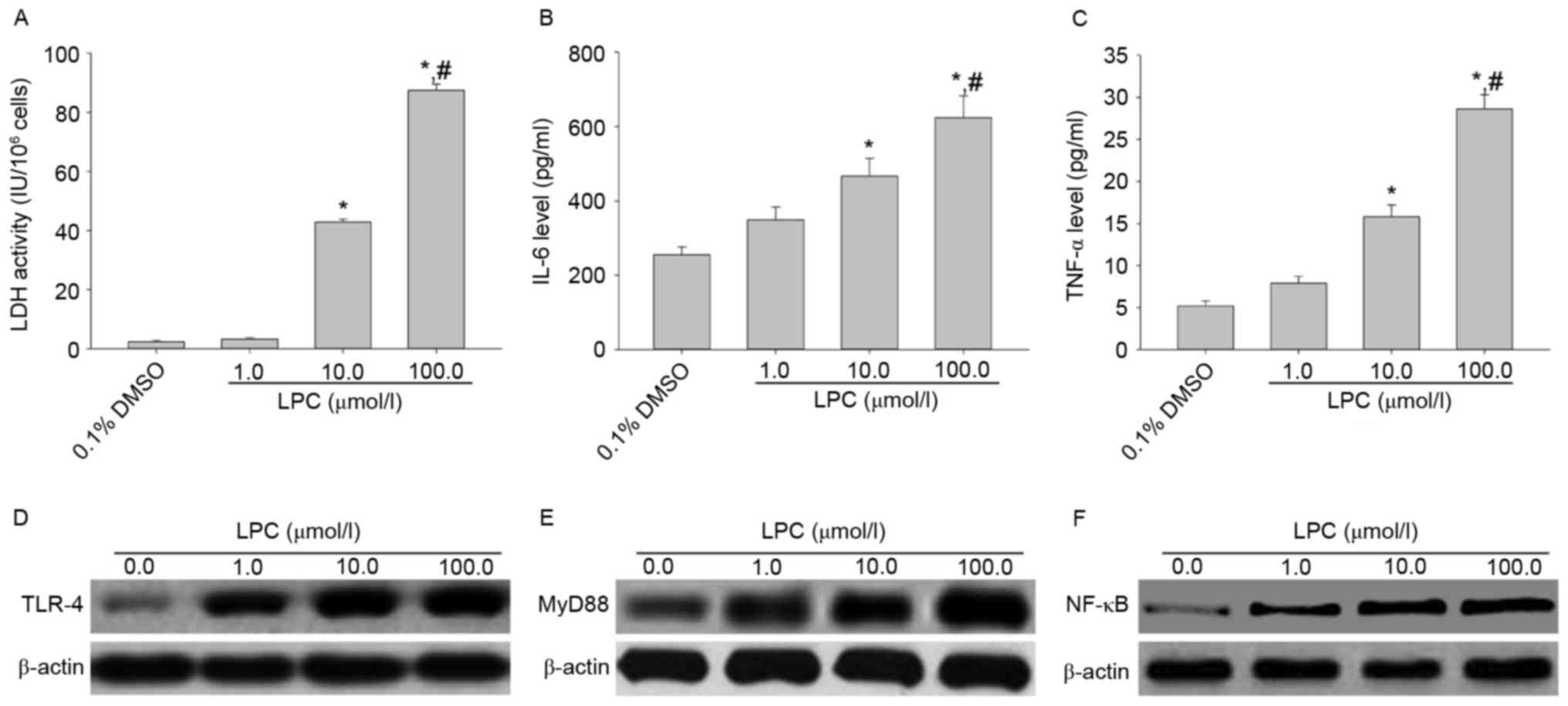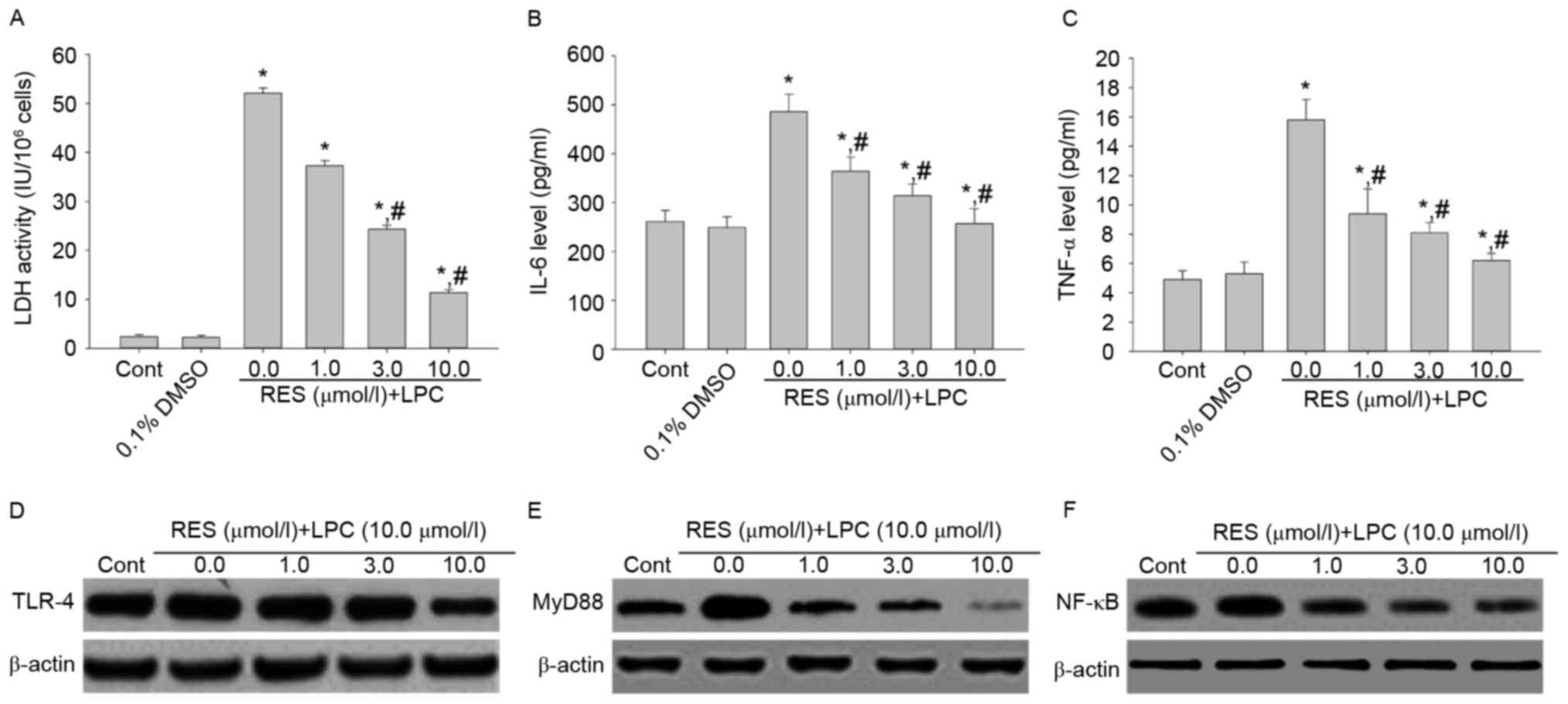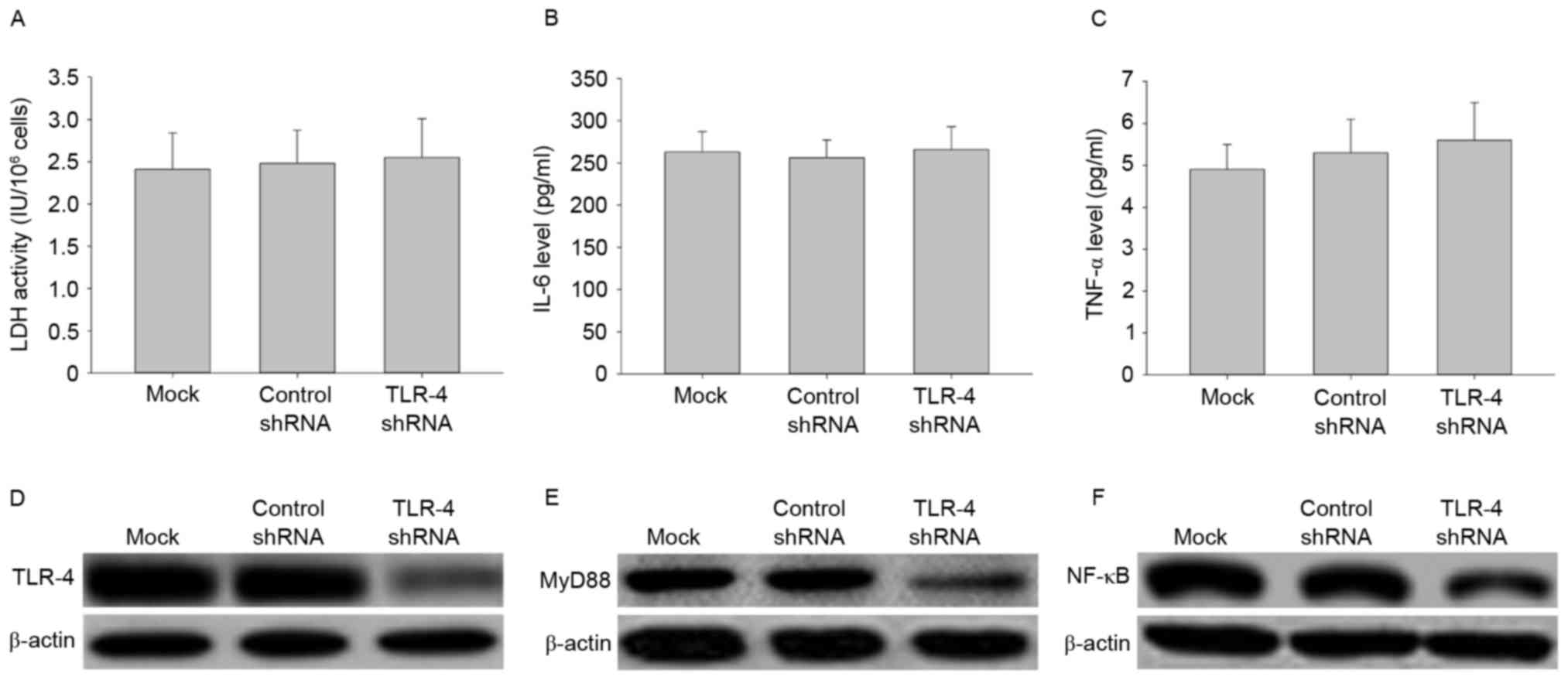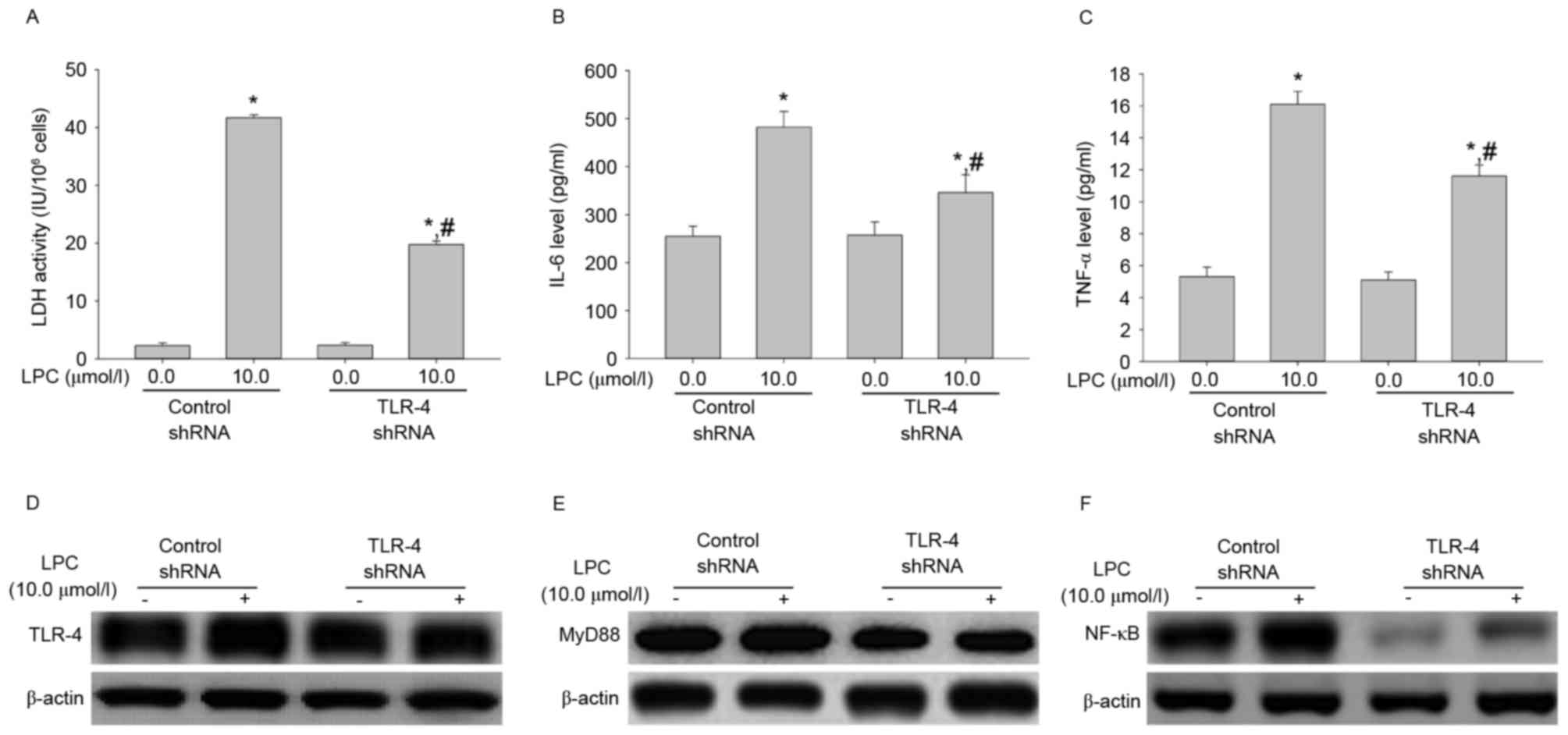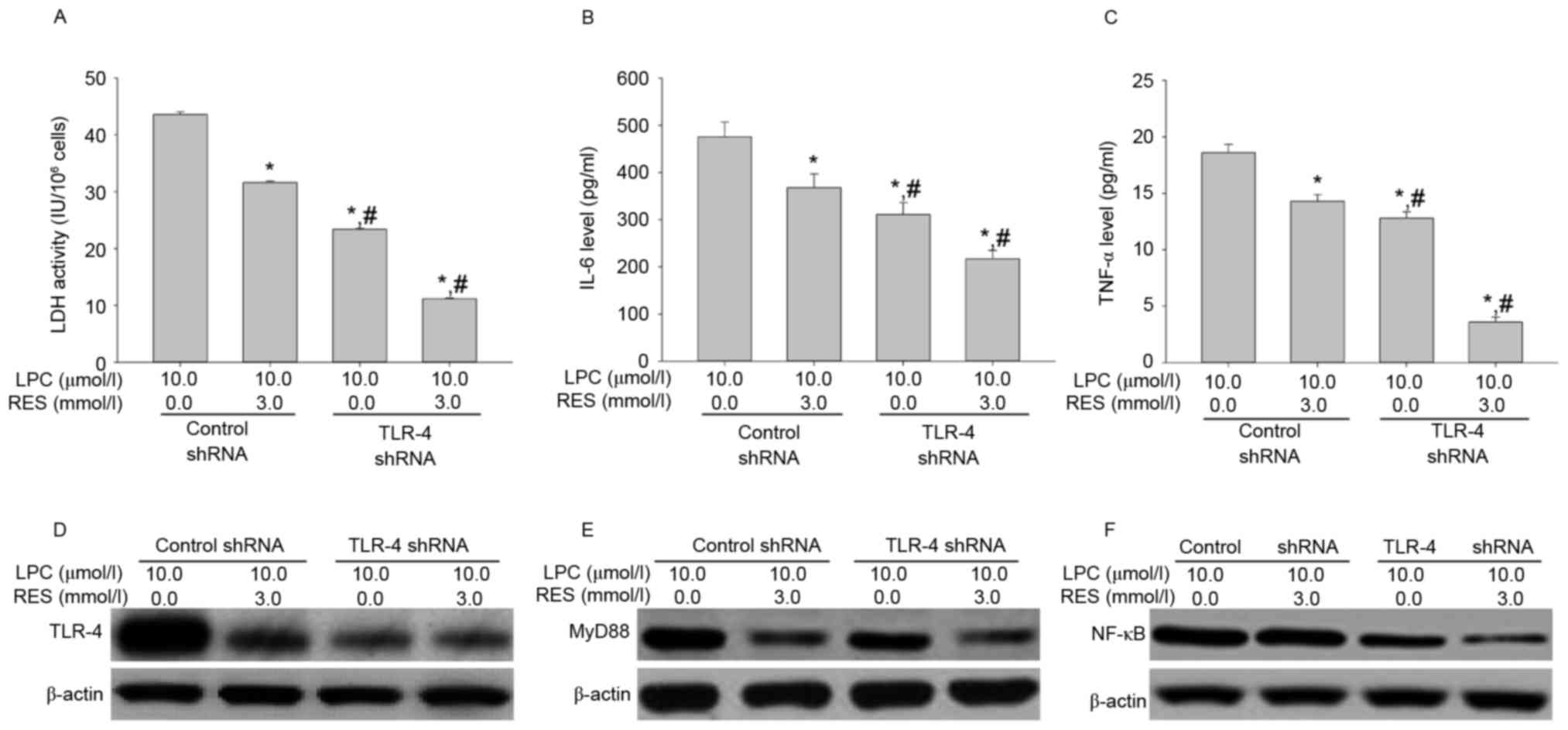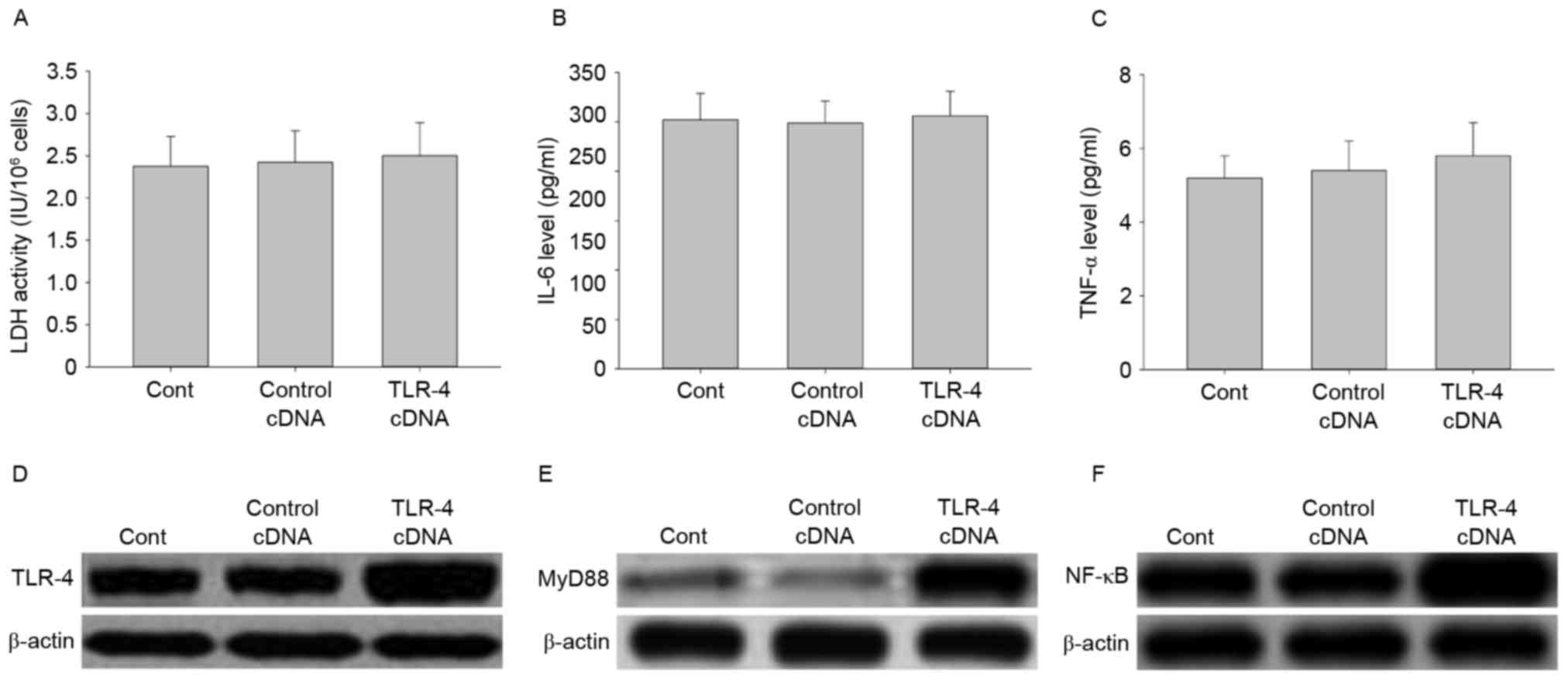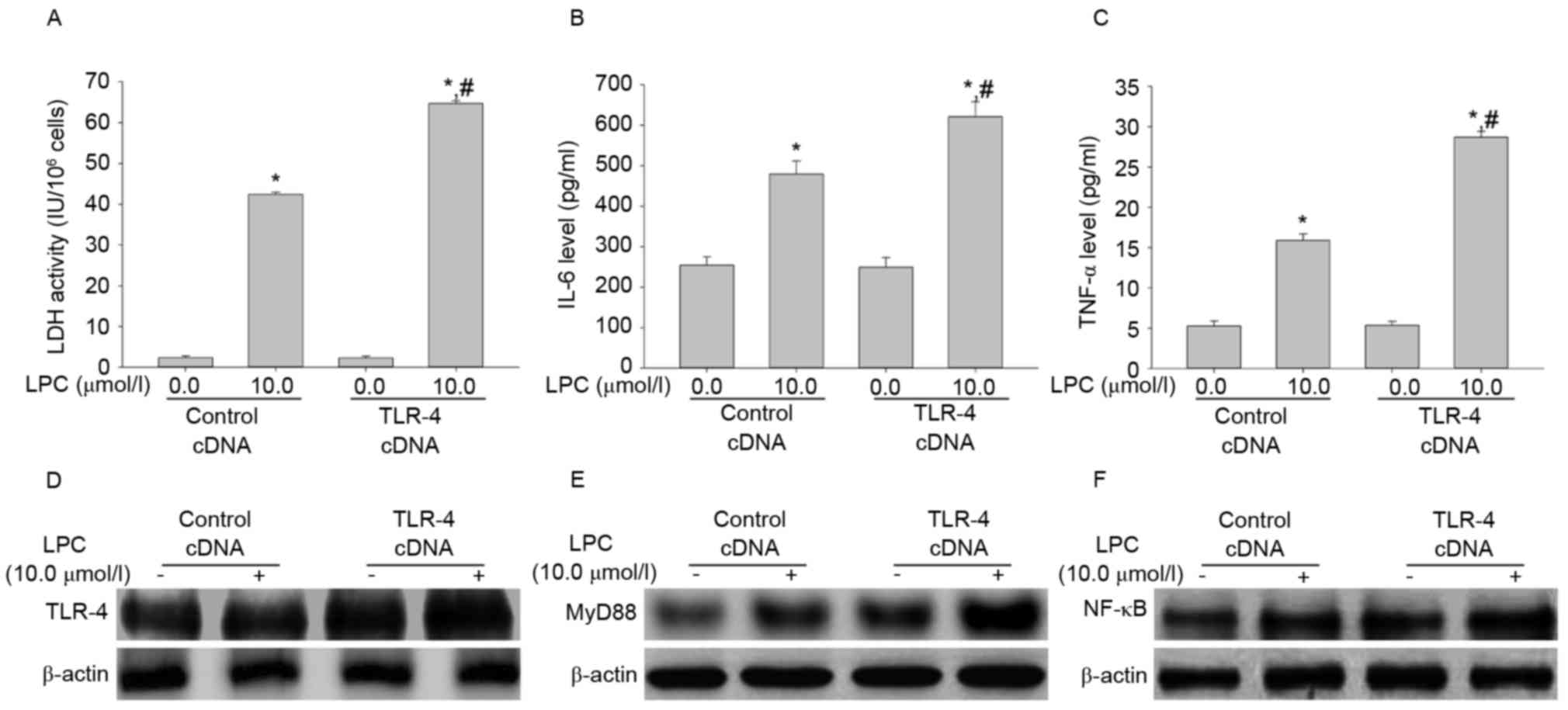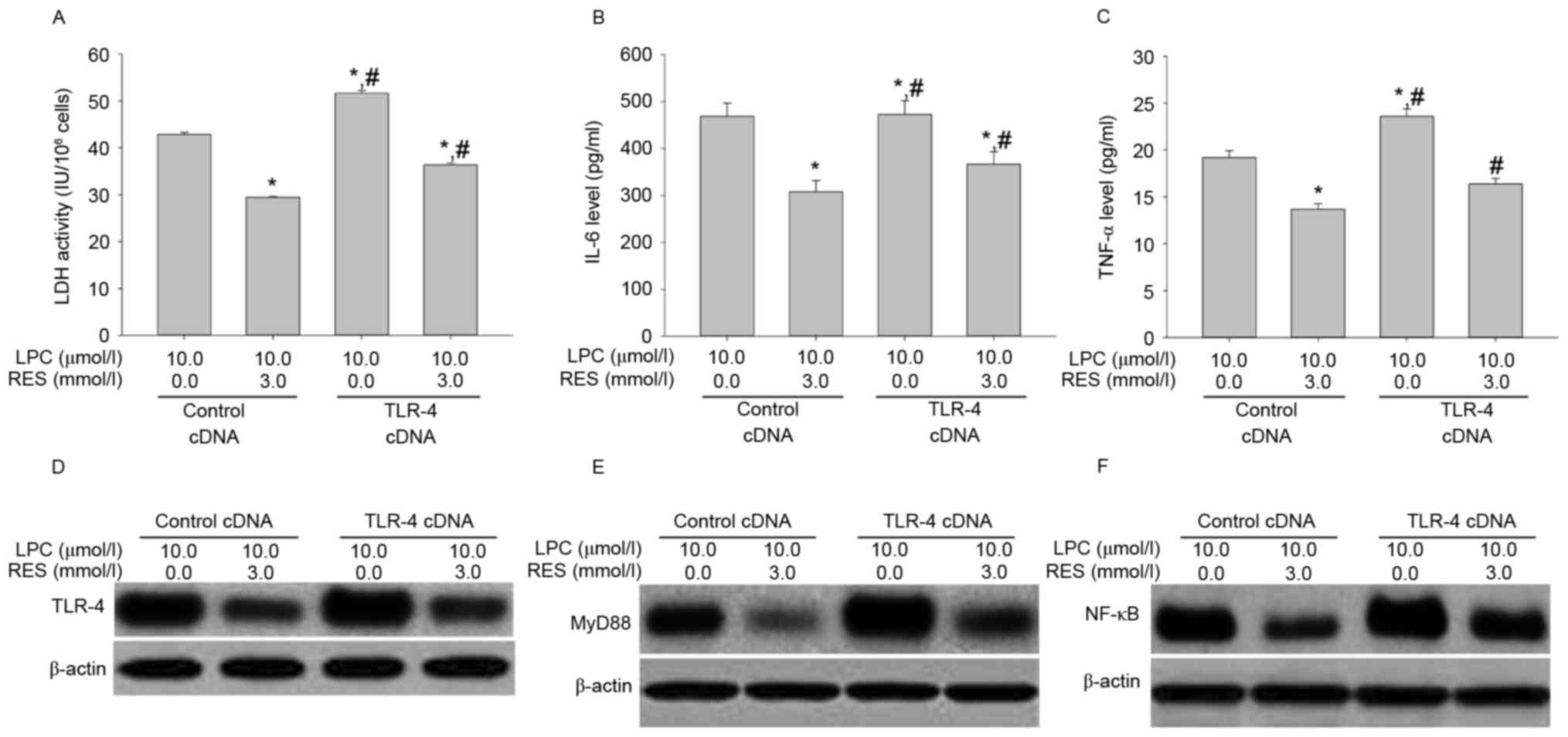Resveratrol alleviates lysophosphatidylcholine-induced damage and inflammation in vascular endothelial cells
- Authors:
- Published online on: December 18, 2017 https://doi.org/10.3892/mmr.2017.8300
- Pages: 4011-4018
Abstract
Introduction
Inflammation serves a key role in the complex biological response to harmful stimuli in atherosclerosis and coronary heart disease. Lysophosphatidylcholine (LPC), the primary constituent of oxidized low density lipoprotein (LDL), effectively induces oxidative stress in vascular endothelial cells and serves a key etiological role in atherosclerosis (1). LPC is upregulated under inflammatory conditions. In addition, inflammation has a causal association with innate immunity (2), diabetes (3) and cancer (4). It may be attributed to a wide variety of inflammatory cytokines, including tumor necrosis factor-α (TNF-α), interleukin (IL)-6 and IL-8 (5). Therefore, intervention with an efficacious anti-inflammatory agent is highly desirable in diseases such as atherosclerosis.
Resveratrol (RES) occurs naturally as a polyphenol in various fruits and vegetables and is abundant in grapes (6). Various studies suggest that RES has anticancer, anti-mutation, cardiovascular, anti-thrombotic, anti-microbial, anti-oxidant and immune strengthening activities. Additionally, RES serves a key anti-inflammatory role in diabetes (3), cancer (4), cardiovascular disease (7) and neurodegenerative disease (8).
A previous study demonstrated that the pharmacological activity of RES may be associated with Toll-like receptor (TLR)-4 (9). TLR-4 belongs to the IL-1 receptor (R)/TLR superfamily. It activates the innate immune system (10). In addition, activation of TLR-4 induces NF-κB expression. The activation of NF-κB induces the expression of IL-6 and TNF-α (11). However, it is not clear whether RES reduces lactate dehydrogenase (LDH) activity and inflammatory cytokine levels via the TLR-4/MyD88/NF-κB signaling pathway in LPC-induced damage and inflammation in vitro. Therefore, the present study investigated the effect of TLR-4-mediated NF-кB signaling in the anti-inflammatory response of RES to LPC-induced damage and inflammation in the HUVE-12 vascular endothelial cell line.
Materials and methods
Reagents
RES was purchased from Sigma-Aldrich; Merck KGaA (Darmstadt, Germany; catalog no. R5010). RPMI1640 culture medium was purchased from Gibco (Thermo Fisher Scientific, Inc., Waltham, MA, USA). The lactic acid dehydrogenase assay kit was supplied by Beckman Coulter, Inc. (Brea, CA, USA) and LPC and anti-β-actin antibodies (cat. no. A4700) were purchased from Sigma-Aldrich; Merck KGaA.
Human TNF-α ELISA (cat. no. BMS223HS) and human IL-6 ELISA (cat. no. EHC007) kits were from NeoBioscience (Shenzhen, China). Anti-TLR-4 (cat. no. AP1504a) and anti-MyD88 (cat. no. 2E9C2) antibodies were from Abgent, Inc. (San Diego, CA, USA). Anti-NF-κB p65 antibodies (cat. no. sc-8008) were provided by Santa Cruz Biotechnology, Inc. (Dallas, TX, USA). OriGene Technologies, Inc. (Rockville, MD, USA) supplied the lentiviral particles packaging of pGFP-V-RS-TLR-4-short hairpin (sh)RNAorpCMV6-AC-GFP-TLR-4-cDNAplasmids.
Cell culture and drug treatment
The human umbilical vein endothelial HUVE-12 cell line was purchased from the Institute of Biochemistry and Cell Biology (Shanghai, China). Cells were cultured at 37°C and 5% CO2 in RPMI-1640 medium (Gibco; Thermo Fisher Scientific, Inc.), supplemented with 10% heat-inactivated fetal calf serum (FCS; Invitrogen; Thermo Fisher Scientific, Inc.), 100 U/ml penicillin, and 100 µg/ml streptomycin. HUVE-12 cells stimulated by LPC (final concentrations: 1.0, 10.0 and 100.0 µmol/l) for 24 h and DMSO (final concentrations: 0.1%) served as the control. In RES treatment experiments, HUVE-12 cells were pretreated with 1, 3 and 10 µmol/l RES for 2 h prior to treatment with 10 µmol/l LPC for 24 h at room temperature.
LDH activity
LDH activity was measured and results analyzed using an automated biochemistry analyzer (Beckman Coulter Chemistry analyzer AU-5800 with an Anjue Medical reagent pack, cat no. 1480, Beckman Coulter, Inc., Brea, CA, USA).
ELISA analysis of IL-6 and TNF-α
Levels of TNF-α or IL-6 were quantified in cell supernatant prepared by centrifugation for 5 min at 2,800 × g using ELISA kits (cat. nos. EHC007 and BMS223HS), according to the manufacturer's protocol. A total of 100 µl serially-diluted standard samples or supernatant samples were added to the microplate and incubated at 37°C for 1 h. Subsequently, 100 µl 1X antibody solution against TNF-α or IL-6 was added to each well and incubated for 37°C for 1 h. A total of 100 µl horseradish peroxidase-conjugated secondary antibody was added to each well for 30 min at 37°C. The plate was washed four times with 100 µl PBS containing 0.1% Tween-20 (PBST) and then the plate was incubated with 100 µl/well substrate in the dark for 15 min. The optical density was measured at a wavelength of 450 nm using a spectrophotometer (Bio-Rad Laboratories, Inc., Hercules, CA, USA).
Cell infection
HUVE-12 cells were seeded onto 24-well plates to a confluence of 40–50% and incubated overnight at 37°C. The cells were infected with lentiviral particles packaging of pGFP-V-RS-TLR-4-shRNA (CCGGCCGCTGGTGTATCTTTGAATACTCGAGTATTCAAAGATACACCAGCGGTTTTTG) or pCMV6-AC-GFP-TLR-4-cDNA (NM_138557) plasmids supplied by OriGene Technologies (Beijing, China) in Opti-MEM (cat. no. 11058–021; Invitrogen; Thermo Fisher Scientific, Inc.) and enhanced infection solution containing 6 µg/ml polybrene (cat. no. REVG0002; Genechem, Inc., Daejeon, Korea). After 4 h, the medium was replaced with RPMI1640 medium containing 10% FCS. Infected cells were cultured for 48 h for the assessment of gene expression by western blotting.
Western blotting
Cells were washed with PBS three times and were lysed on ice with radioimmunoprecipitation assay buffer containing 1% phenylmethylsulfonyl fluoride (Santa Cruz Biotechnology, Inc.). SDS-PAGE (10 or 12%) was used to separate the proteins in the lysates (40 µg protein), followed by electroblotting of the proteins onto a polyvinylidene difluoride membrane (EMD Millipore, Billerica, MA, USA). Membranes were blocked in 5% non-fat milk in PBST for 1 h at room temperature, and probed with the following mouse anti-human primary monoclonal antibodies: Anti-TLR-4 (1:1,000), anti-MyD88 (1:1,000), anti-NF-κBp65 (1:1,000) and anti-β-actin (1:2,000), under slight vibration at 4°C overnight. Membranes were subsequently incubated with a goat polyclonal secondary antibody (cat. no. 31430; 1:500; Invitrogen; Thermo Fisher Scientific, Inc.) to mouse immunoglobulin Gse immunoglobulin G for 1 h at room temperature, followed by an Enhanced Chemiluminescence substrate solution (GE Healthcare; Chicago, IL, USA).
Statistical analysis
Data are expressed as the mean ± standard deviation. SPSS software version 15.0 (SPSS, Inc., Chicago, IL, USA) was used for statistical analysis and a one-way analysis of variance followed by Tukey's post-hoc test was used to analyze significant differences in mean values. P<0.05 was considered to indicate a statistically significant difference.
Results and Discussion
Effects of LPC on LDH activity, IL-6 and TNF-αsecretion, and TLR-4, MyD88 and NF-κB expression in HUVE-12 cells
Treatment of HUVE-12 cells with 10 and 100 µmol/l LPC significantly enhanced LDH activity and the levels of IL-6 and TNF-α compared with cells treated with 0.1% DMSO (0 µmol/l LPS; P<0.01; Fig. 1A-C), which suggested that LPC induced damage and inflammation. In addition, treatment with 1, 10 and 100 µmol/l LPC elevated the expression levels of TLR-4, MyD88 and NF-κB p65 in HUVE-12 cells in a concentration-dependent manner compared with cells treated with 0 µmol/l LPC (Fig. 1D-F). These results suggested that TLR-4 signaling mediates HUVE-12 cell injury induced by LPC. LDH is a marker of injury and diseases, including heart failure (12). Oxidation and enzymatic modification of low density lipoprotein (LDL) leads to lysophosphatidylcholine (LPC) synthesis in atherosclerosis (12). LPC induces inflammation in coronary artery smooth muscle cells (13). Qin et al (14) demonstrated that LPC maintains macrophage polarization towards a classically activated phenotype in inflammation. Li et al (15) reported that LPC induces the secretion of inflammatory factors in human umbilical vein endothelial cells. The results of the present study suggested that LPC increased LDH activity and expression of the inflammatory cytokines, IL-6 and TNF-α, suggesting that LPC induced injury and inflammation in HUVE-12 cells.
Pathogens, cytokines and environmental stimuli alter TLR-4 expression in vascular injury and the inflammatory response. TLRs mediate zinc/nickel-induced inflammation in endothelial cells (16). Wang et al (17) reported that TLR-4 stimulates proliferation and an inflammatory response in LPS-induced Hep G2 cells. Bomfim et al (18) suggested that TLR-4 mediates hypertension and vascular inflammation via NF-κB signaling. The interaction between TLR-4 and proteinase-activated receptor 2 [PAR (2)] contributes to vascular homeostasis (19). The present study demonstrated that TLR-4 signaling may be involved in LPC-induced injury and inflammation in HUVE-12 cells.
Effect of RES on LDH activity, IL-6 and TNF-αsecretion, and TLR-4, MyD88 and NF-κB p65 expression
To examine whether RES protects against LPC-induced injury and inflammation, HUVE-12 cells were pretreated with 1, 3 and 10 µmol/l RES prior to treatment with 10 µmol/l LPC. RES inhibited the effects of LPC on LDH activity and cytokine expression compared with cells treated with 0 µmol/l RES and LPC (P<0.01; Fig. 2A-C). In addition, RES suppressed the expression levels of TLR-4, MyD88 and NF-κB compared with cells treated with 0 µmol/l RES (Fig. 2D-F), which were upregulated by LPC treatment alone. RES has been reported to exhibit anti-atherogenic effects (20). Various studies suggested that RES protects cardiomyocytes against injury via the TLR-4/NF-κB signaling pathway (21,22). The results of the present study revealed that RES may protect from the LPC-induced damage and inflammation by inhibiting the TLR-4/MyD88/NF-κB signaling pathway.
Effects of TLR-4 shRNA transfection on LDH activity, IL-6 and TNF-αsecretion, and signal transduction
To further investigate the role of TLR-4 in LPC-induced damage and inflammation in HUVE-12 cells, TLR-4 shRNA transduction was performed to silence the TLR-4 gene. Transfection with TLR-4-shRNA did not affect LDH activity or expression of IL-6 and TNF-α in HUVE-12 cells (Fig. 3A-C), despite demonstrating that transfection with TLR-4-shRNA significantly decreased the expression levels of TLR-4 and its downstream targets, MyD88 and NF-κB, compared with cells transfected with control shRNA (Fig. 3D-F). These results suggested that knockdown of TLR-4 silenced the TLR-4 gene to inhibit the TLR-4/MyD88/NF-κB signaling pathway; while it had little effect on injury and inflammatory factor secretion of HUVE-12 cells.
TLR-4 shRNA transfection influences LDH activity, IL-6 and TNF-αsecretion, and signal transduction induced by LPC treatment
To evaluate the effect of TLR-4 shRNA on LPC-induced damage and inflammation, the LDH activity and levels of IL-6 and TNF-α were measured. As demonstrated in Fig. 4A-C, transfection with TLR-4 shRNA significantly inhibited the effects of LPC on LDH activity and IL-6 and TNF-α cytokine secretion, compared with control shRNA (P<0.01). Furthermore, TLR-4 shRNA suppressed LPC-induced upregulation of signaling molecules compared with control shRNA (Fig. 4D-F). This suggested that TLR-4 gene silencing may protect from LPC-induced damage and inflammation.
Effects of RES therapy and TLR-4 shRNA transfection on LDH activity, IL-6 and TNF-αsecretion, and TLR-4, MyD88 and NF-κB expression
To investigate whether RES inhibits LPC-induced damage and inflammation in human umbilical vein endothelial cells, the effect of RES in combination with TLR-4 shRNA on LPC-induced damage and inflammation in HUVE-12 cells was investigated. RES treatment and TLR-4 shRNA transfection suppressed the effects of LPC on LDH activity and IL-6 and TNF-α secretion (P<0.01; Fig. 5A-C), the expression of TLR-4 and MyD88 were weakly downregulated, and the expression of NF-κB were markedly downregulated (Fig. 5D-F). These data suggested that RES inhibited expression of NF-κB may have involved another mechanism.
A previous study demonstrated that the pharmacological activity of RES may be associated with TLR-4. The interaction of TLR-4 with MyD88 activates TNF receptor-associated factor, to activate the inflammatory cascade (23). TLR-4 may mediate MyD88-dependent NF-κB activation, which increases the production of inflammatory cytokines. The results of the present study suggested that RES attenuates LPC-induced damage and inflammation in HUVE-12 cells by inhibiting the TLR-4/MyD88/NF-κB signaling pathway.
Effect of TLR-4 overexpression on LDH activity, IL-6 and TNF-αsecretion, and signal transduction
To further investigate the role of TLR-4 in LPC-induced damage and inflammation in HUVE-12 cells, cells were transfected with TLR-4 cDNA to overexpress the TLR-4 gene. As demonstrated in Fig. 6A-C, no significant differences were observed in LDH activity and cytokine expression between cells transfected with the control cDNA and TLR-4 cDNA (P>0.05). However, the expression levels of TLR-4 and its downstream proteins including MyD88 and NF-κB, were elevated by TLR-4 overexpression (Fig. 6D-F). These results suggested that overexpression of TLR-4 may activate the TLR-4/MyD88/NF-κB signaling pathway.
Effect of TLR-4 overexpression on LDH activity, IL-6 and TNF-αsecretion, and signal transduction induced by LPC
To determine the effect of TLR-4 overexpression on LPC-induced damage and inflammation, the LDH activity and levels of IL-6 and TNF-α were measured. Transfection with TLR-4 cDNA enhanced LPC-induced LDH activity and IL-6 and TNF-α levels compared with cells transfected with control cDNA in HUVE-12 cells (P<0.01; Fig. 7A-C). The expression levels of TLR-4, MyD88 and NF-κB in cells transfected with TLR cDNA was higher than in the control cDNA group after LPC treatment (Fig. 7D-F), which suggested that TLR-4 may be associated with NF-κB signaling during LPC-induced damage and inflammation (18).
Effects of RES treatment combined with TLR-4 cDNA transduction on LDH activity, IL-6 and TNF-αsecretion, and signal transduction
To confirm that the effects of RES inhibited LPC-induced damage and inflammation in human umbilical vein endothelial cells via regulation of the TLR-4/MyD88/NF-κB signaling pathway, the effect of RES treatment and TLP4 overexpression on LPC-induced damage and inflammation in HUVE-12 cells was investigated. RES significantly suppressed the effects of TLR-4 overexpression on LPC-induced damage and inflammation (P<0.01; Fig. 8A-F).
RES was reported to exhibit anti-atherogenic effects (20). Various studies suggested that RES protects cardiomyocytes against injury via the TLR-4/NF-κB signaling pathway (21,22). The results of the present study supported the critical role served by TLR-4/MyD88/NF-κB signaling in LPC-induced injury and pro-inflammatory responses. In addition, the present study demonstrated that RES attenuated the inflammatory reaction induced by LPC in HUVE-12 cells via downregulation of the TLR-4/MyD88/NF-κB signaling pathway. The present study reported that RES exercises protective actions in the first steps of the atherogenic process. Reducing the expression of adhesion molecules (intercellular adhesion molecule-1, and vascular cell adhesion molecule-1) via inhibition of NF-κB pathway activation by RES was demonstrated by Deng et al (24). The present study also provided evidence that RES inhibited NF-κB activation through blocking TLR-4/MyD88/NF-κB signal pathway. The results highlight the anti-inflammatory properties and potential molecule mechanism of RES. Bonnefont-Rousselot (25) suggested that RES is a good candidate, owing to its protective action of vascular walls towards oxidation, inflammation, platelet oxidation and thrombus formation. RES may be beneficial in preventing the development of atherosclerosis. However, further studies with animal models are required to validate the findings of the present study.
Glossary
Abbreviations
Abbreviations:
|
RES |
resveratrol |
|
LPC |
lysophosphatidylcholine |
|
LDH |
lactate dehydrogenase |
|
HUVE-12 cells |
human umbilical vein endothelial-12 cells |
|
LDL |
low density lipoprotein |
|
TNF-α |
tumor necrosis factor-α |
|
IL-6 |
interleukin-6 |
|
OD |
optical density |
References
|
Domeij H, Hua X, Su J, Bäcklund A, Yan Z, Frostegard AG, Haeggström JZ, Modéer T and Frostegard J: Annexin A5 inhibits atherogenic and pro-inflammatory effects of lysophosphatidylcholine. Prostaglandins Other Lipid Mediat. 106:72–78. 2013. View Article : Google Scholar : PubMed/NCBI | |
|
Sheldon IM, Cronin JG, Healey GD, Gabler C, Heuwieser W, Streyl D, Bromfield JJ, Miyamoto A, Fergani C and Dobson H: Innate immunity and inflammation of the bovine female reproductive tract in health and disease. Reproduction. 148:R41–R51. 2014. View Article : Google Scholar : PubMed/NCBI | |
|
Gao W, Zhou Y, Li Q, Zhou Q, Tan L, Song Y, Zhao X, Yu M, Zheng S, Ye H, et al: Analysis of global gene expression profiles suggests a role of acute inflammation in type 3C diabetes mellitus caused by pancreatic ductal adenocarcinoma. Diabetologia. 58:835–844. 2015. View Article : Google Scholar : PubMed/NCBI | |
|
Coussens LM and Werb Z: Inflammation and cancer. Nature. 420:860–867. 2002. View Article : Google Scholar : PubMed/NCBI | |
|
Strowig T, Henao-Mejia J, Elinav E and Flavell R: Inflammasomes in health and disease. Nature. 481:278–286. 2012. View Article : Google Scholar : PubMed/NCBI | |
|
Bradamante S, Barenghi L and Villa A: Cardiovascular protective effects of resveratrol. Cardiovasc Drug Rev. 22:169–188. 2004. View Article : Google Scholar : PubMed/NCBI | |
|
Libby P, Ridker PM and Maseri A: Inflammation and atherosclerosis. Circulation. 105:1135–1143. 2002. View Article : Google Scholar : PubMed/NCBI | |
|
Kim D, Nguyen MD, Dobbin MM, Fischer A, Sananbenesi F, Rodgers JT, Delalle I, Baur JA, Sui G, Armour SM, et al: SIRT1 deacetylase protects against neurodegeneration in models for Alzheimer's disease and amyotrophic lateral sclerosis. EMBO J. 26:3169–3179. 2007. View Article : Google Scholar : PubMed/NCBI | |
|
Youn HS, Lee JY, Fitzgerald KA, Young HA, Akira S and Hwang DH: Specific inhibition of MyD88-independent signaling pathways of TLR3 and TLR4 by resveratrol: Molecular targets are TBK1 and RIP1 in TRIF complex. J Immunol. 175:3339–3346. 2005. View Article : Google Scholar : PubMed/NCBI | |
|
Apetoh L, Ghiringhelli F, Tesniere A, Obeid M, Ortiz C, Criollo A, Mignot G, Maiuri MC, Ullrich E, Saulnier P, et al: Toll-like receptor 4-dependent contribution of the immune system to anticancer chemotherapy and radiotherapy. Nat Med. 13:1050–1059. 2007. View Article : Google Scholar : PubMed/NCBI | |
|
Huang RL, Yuan Y, Zou GM, Liu G, Tu J and Li Q: LPS-stimulated inflammatory environment inhibits BMP-2-induced osteoblastic differentiation through crosstalk between TLR4/MyD88/NF-kB and BMP/Smad signaling. Stem Cells Dev. 23:277–289. 2014. View Article : Google Scholar : PubMed/NCBI | |
|
Augoff K, Hryniewicz-Jankowska A and Tabola R: Lactate dehydrogenase 5: An old friend and a new hope in the war on cancer. Cancer Lett. 358:1–7. 2015. View Article : Google Scholar : PubMed/NCBI | |
|
Aiyar N, Disa J, Ao Z, Ju H, Nerurkar S, Willette RN, Macphee CH, Johns DG and Douglas SA: Lysophosphatidylcholine induces inflammatory activation of human coronary artery smooth muscle cells. Mol Cell Biochem. 295:113–120. 2007. View Article : Google Scholar : PubMed/NCBI | |
|
Qin X, Qiu C and Zhao L: Lysophosphatidylcholine perpetuates macrophage polarization toward classically activated phenotype in inflammation. Cell Immunol. 289:185–190. 2014. View Article : Google Scholar : PubMed/NCBI | |
|
Li JZ, Wu JH, Yu SY, Shao QR and Dong XM: Inhibitory effects of paeoniflorin on lysophosphatidylcholine-induced inflammatory factor production in human umbilical vein endothelial cells. Int J Mol Med. 31:493–497. 2013. View Article : Google Scholar : PubMed/NCBI | |
|
Tsou TC, Liou SH, Yeh SC, Tsai FY and Chao HR: Crucial role of Toll-like receptors in the zinc/nickel-induced inflammatory response in vascular endothelial cells. Toxicol Appl Pharmacol. 273:492–499. 2013. View Article : Google Scholar : PubMed/NCBI | |
|
Wang Y, Tu Q, Yan W, Xiao D, Zeng Z, Ouyang Y, Huang L, Cai J, Zeng X, Chen YJ and Liu A: CXC195 suppresses proliferation and inflammatory response in LPS-induced human hepatocellular carcinoma cells via regulating TLR4-MyD88-TAK1-mediated NF-kB and MAPK pathway. Biochem Biophys Res Commun. 456:373–379. 2015. View Article : Google Scholar : PubMed/NCBI | |
|
Bomfim GF, Echem C, Martins CB, Costa TJ, Sartoretto SM, Dos Santos RA, Oliveira MA, Akamine EH, Fortes ZB, Tostes RC, et al: Toll-like receptor 4 inhibition reduces vascular inflammation in spontaneously hypertensive rats. Life Sci. 122:1–7. 2015. View Article : Google Scholar : PubMed/NCBI | |
|
Bucci M, Vellecco V, Harrington L, Brancaleone V, Roviezzo F, Mattace Raso G, Ianaro A, Lungarella G, De Palma R, Meli R and Cirino G: Cross-talk between Toll-like receptor 4 (TLR4) and proteinase-activated receptor 2 (PAR (2)) is involved in vascular function. Br J Pharmacol. 168:411–420. 2013. View Article : Google Scholar : PubMed/NCBI | |
|
Riccioni G, Gammone MA, Tettamanti G, Bergante S, Pluchinotta FR and D'Orazio N: Resveratrol and anti-atherogenic effects. Int J Food Sci Nutr. 66:603–610. 2015. View Article : Google Scholar : PubMed/NCBI | |
|
Zhang C, Lin G, Wan W, Li X, Zeng B, Yang B and Huang C: Resveratrol, a polyphenol phytoalexin, protects cardiomyocytes against anoxia/reoxygenation injury via the TLR4/NF-κB signaling pathway. Int J Mol Med. 29:557–563. 2012. View Article : Google Scholar : PubMed/NCBI | |
|
Li J, Xie C, Zhuang J, Li H, Yao Y, Shao C and Wang H: Resveratrol attenuates inflammation in the rat heart subjected to ischemia-reperfusion: Role of the TLR4/NF-κB signaling pathway. Mol Med Rep. 11:1120–1126. 2015.PubMed/NCBI | |
|
Feng Y and Longmore GD: The LIM protein Ajuba influences interleukin-1-induced NF-kappaB activation by affecting the assembly and activity of the protein kinase Czeta/p62/TRAF6 signaling complex. Mol Cell Biol. 25:4010–4022. 2005. View Article : Google Scholar : PubMed/NCBI | |
|
Deng YH, Alex D, Huang HQ, Wang N, Yu N, Wang YT, Leung GP and Lee SM: Inhibition of TNF-α-mediated endothelial cell-monocyte cell adhesion and adhesion molecules expression by the resveratrol derivative, trans-3,5,4′-trimethoxystilbene. Phytother Res. 25:451–457. 2011.PubMed/NCBI | |
|
Bonnefont-Rousselot D: Resveratrol and cardiovascular diseases. Nutrients. 8:2502016. View Article : Google Scholar : |



